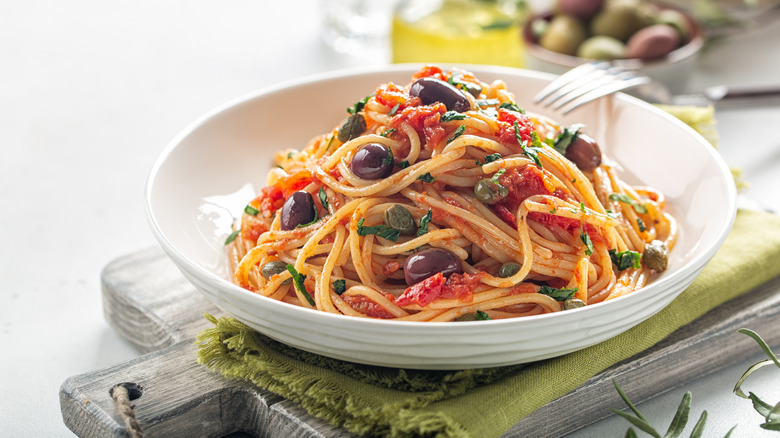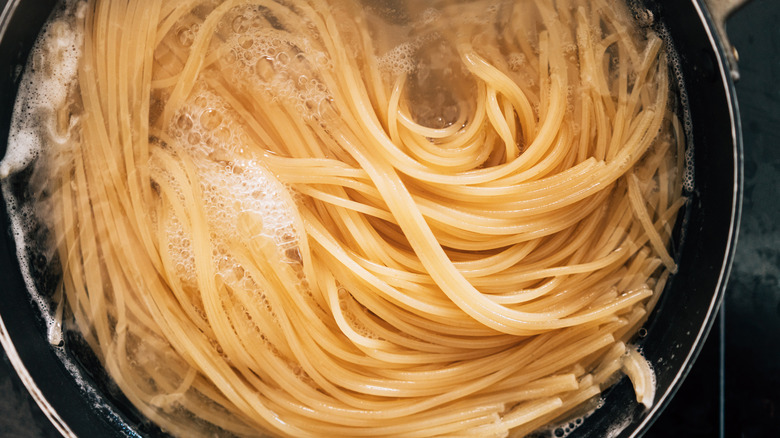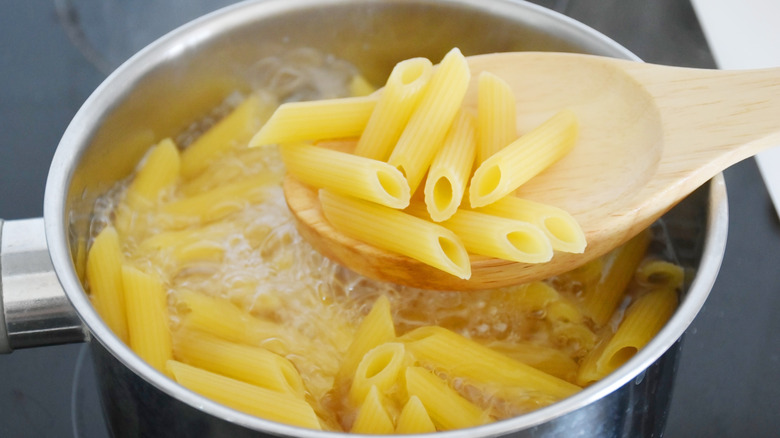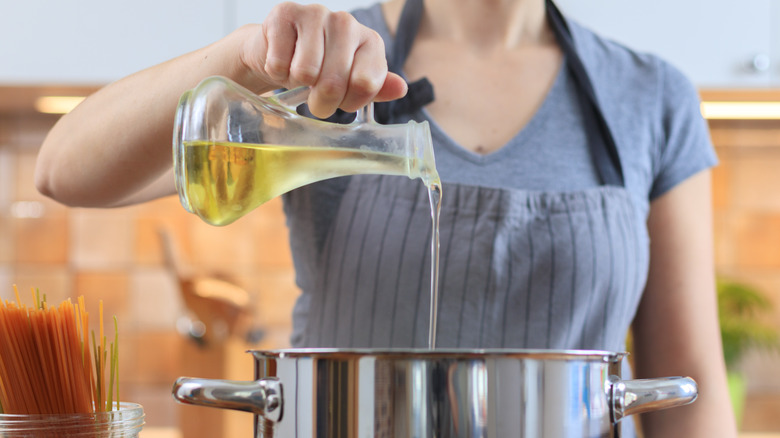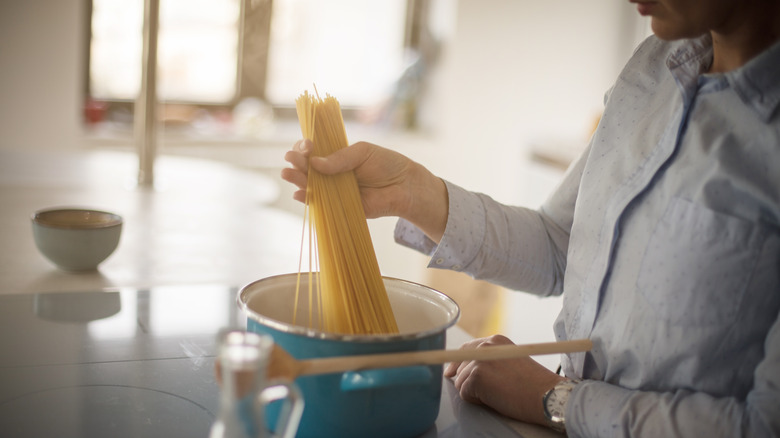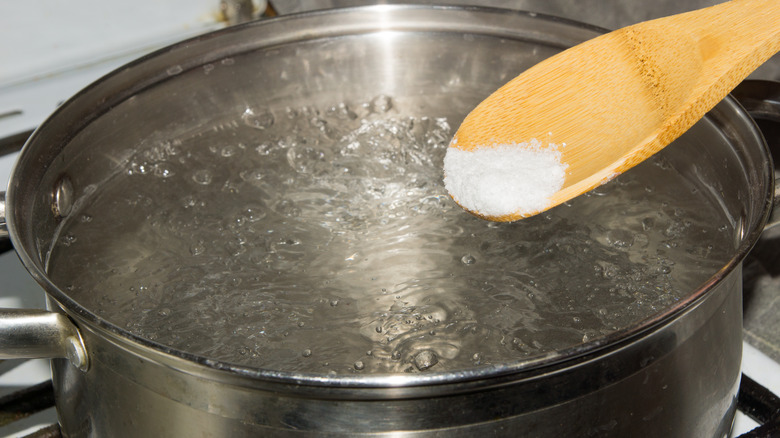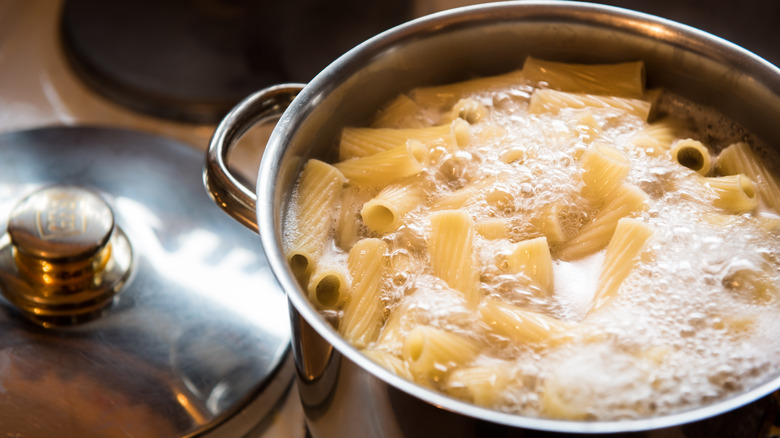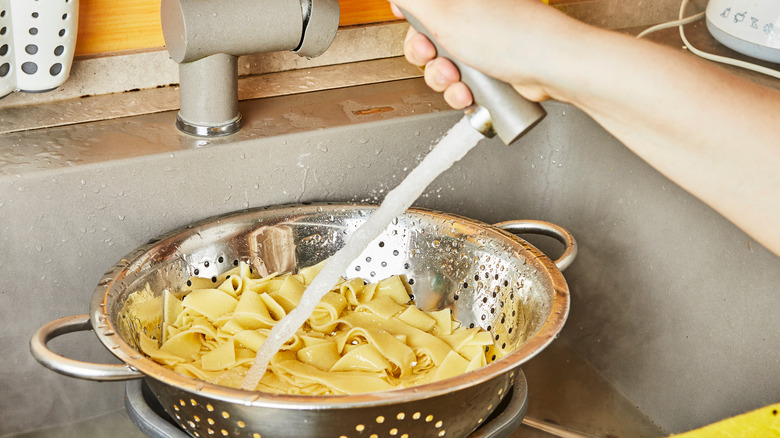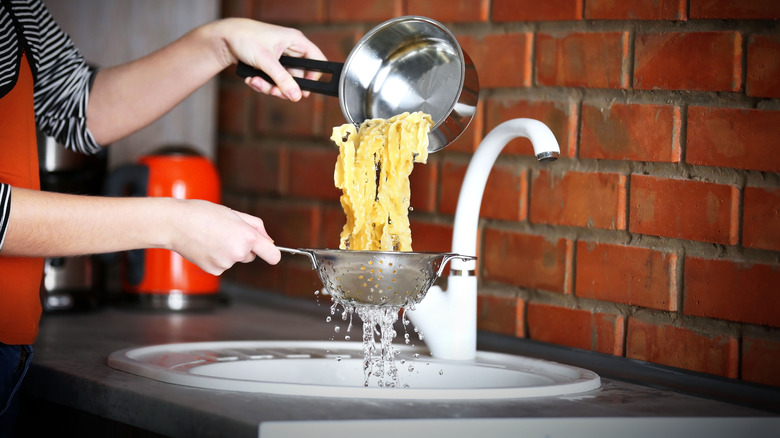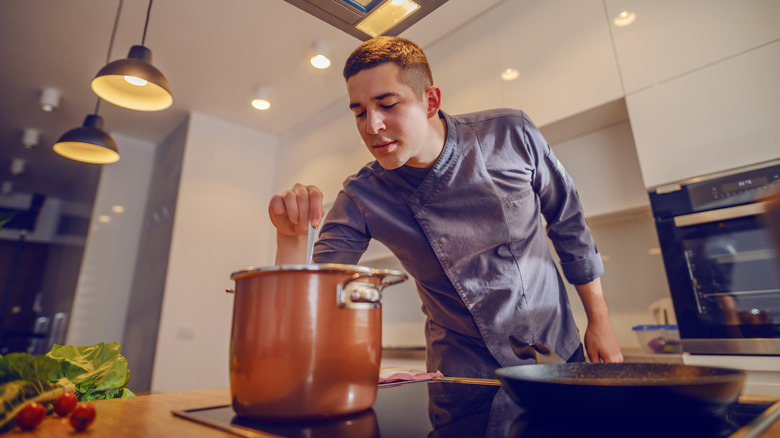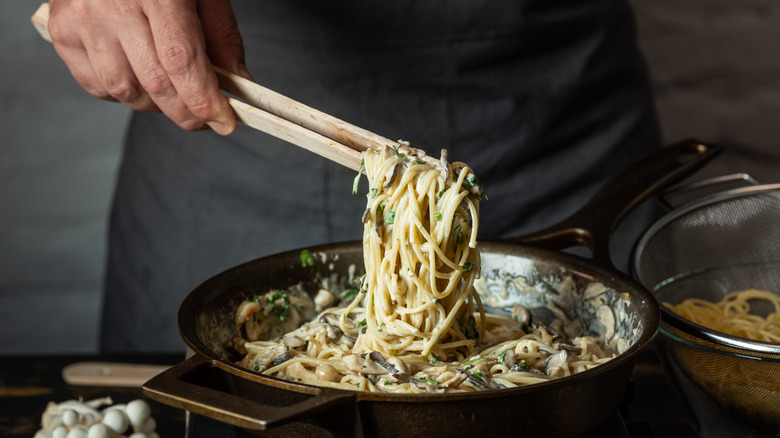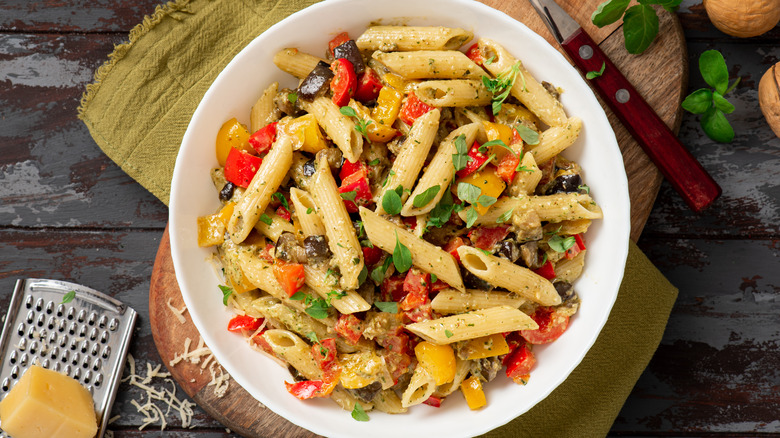The Biggest Mistakes You Need To Avoid With Pasta
There's nothing quite like pasta. From macaroni and cheese to spaghetti bolognese, there's a pasta dish for everyone and almost as many ways to prepare it. Thomas Jefferson was so impressed with macaroni that he brought it to the U.S. during one of his trips to Europe. When Italian immigrants made their way to the country, pasta became a staple in many kitchens, and it is as popular today as it always has been (via PBS).
The great thing about pasta is that you can whip up a meal most of the time within just a few minutes. For those instances when you don't have a lot of time or energy, pasta can be a lifesaver. But as easy as cooking pasta can be, sometimes pasta doesn't turn out just right, leaving you wondering what you did wrong. To help, we've combed the internet and found the biggest mistakes you might be making when cooking pasta.
Using a pot that is too small
While you might be tempted to cook pasta in a small pot to save time, Southern Living recommends that you shouldn't for a few reasons. For starters, when you add pasta to a small amount of boiling water, it cools down the water, which means it will be sitting in warm (not boiling) water for too long. The result may leave you with pasta pieces that stick together.
In addition to plenty of water, pasta needs space to properly cook. If your pot is too small, you'll end up with the same problem as not enough water — pasta clumping together. The Spruce Eats recommends that for each pound of pasta, your pot should hold anywhere from six to eight quarts of water, and you should be able to fill it ¾ full of water to give pasta the space it needs to cook.
Not using enough water
Even if you use the right-size pot, you still need to make sure you use enough water to avoid pasta sticking together. Eating Well explains that pasta needs more water than most people think to cook. The amount of water you use to cook pasta serves two purposes. For one, it gives each pasta piece plenty of room in the pot, which means they won't be bumping each other and clumping together. Secondly, plenty of water means that the starch released by the pasta will stay in the water rather than cling to the pieces.
You want some starch on the pasta, but not too much. Too much starch on the pasta makes it sticky, which can also make the pasta pieces cling to one another in chunks. For the best results, you will need at least 2½ quarts of water to cook 8 ounces of pasta.
Adding oil to the water
You may be familiar with the idea of adding oil to pasta water to keep the water from boiling over or to prevent pasta from sticking together. But, according to Reader's Digest, you should never do this, and the reason comes down to science. Simply put, water and oil do not mix. When you add oil to the water, most of it is going to stick to the pasta, which means you'll end up with slippery noodles.
You might not think that a little bit of oil on your pasta is bad, but adding this ingredient makes it difficult for the sauce to stick to the pasta. You can eliminate the need for any oil by using enough water in a pot that gives it plenty of room to move. Stirring the pasta as soon as you put it in the boiling water will also prevent noodles from sticking together.
Adding pasta to the water too soon
We've all been there: waiting for water to boil. When you see small bubbles forming at the bottom of the pot, you may think that the water is close enough to boiling that it won't matter. But the truth is, while it might not seem like a minute would make much of a difference when it comes to cooking pasta, it actually does. If your water isn't at a rolling boil when you put the pasta in it, the pasta ends up sitting in warm water for too long, and it will most likely become a sticky mess as a result, per Southern Living.
According to Smithsonian Magazine, the temperature of the water when you add the pasta is crucial to how it will turn out, explaining that the boiling nature of the water is what keeps the pasta from becoming mushy and clumpy.
Not adding salt
Good Housekeeping explains that not adding enough salt to the water is the biggest mistake home cooks make when it comes to cooking pasta. This is because as the pasta cooks in salty water, the salt flavors the pasta from the inside out. The end result is pasta that has more of an overall, deep flavor, per The Spruce Eats.
And it matters when you add it. According to Good Housekeeping, the best time to add salt to the water is after the water comes to a boil; adding that, you can't really add too much salt to pasta water because most of it stays in the water anyway. That said, a small palmful of salt for each pound of pasta should be good. If you would like something a little more specific, The Spruce Eats recommends about 2 tablespoons of salt for every gallon of water you use.
Overcooking the pasta
Most packages of pasta come with instructions, which is good because that can give you a general idea of when to check your pasta. However, you should still test the noodles before removing them from the water. The Spruce Eats explains that pasta is considered cooked when it's "al dente," which means "to the tooth" in Italian.
Rather than follow the box instructions to a tee, it's best to test the pasta a minute or two before the recommended time to remove it from the water. The trick is removing the pasta before it gets too mushy. That said, if you remove pasta from the water too soon, it'll be hard and chewy. So, it's best to check to be sure. If the center of the pasta is white, it means the noodle is not quite cooked. When the outside of the noodle is softer than the inside, your pasta is perfectly cooked.
Rinsing the pasta
Because pasta releases starch during the cooking process, some of that starch will end up in the water, while some will also end up on the pasta. You might think this is a bad thing because it means that the pasta might be sticky. But the starch doesn't add stickiness to the pasta as much as it does a coating (via Delish).
This coating has an important purpose — it allows the sauce to stick to the pasta. Rinsing pasta after it's cooked removes this important layer of starch, which means the sauce won't cling to the noodles, according to Delish. For the best pasta dish experience, the pasta and the sauce need to bond to each other, and that thin layer of starch on the pasta allows that to happen. In addition, Smithsonian explains that the starch also adds a little bit of flavor to the pasta.
Throwing out the pasta water
You might not think there is much use for the water after removing the pasta, but there is — especially if you're making a homemade sauce. According to The Spruce Eats, the best thing you can do with pasta water is add it to your sauce. The salty, starchy pasta water not only adds flavor to the sauce but also thickens it. That starchiness also helps the pasta sauce stick to individual pasta pieces, ensuring they all get an equal amount of flavorful sauce.
In addition, if your sauce ends up coming out too chunky, adding a bit of the pasta water will help thin it out. Good Housekeeping explains that pasta water might not make as much of a difference when making marinara or bolognese sauces; it's excellent for adding a velvety finish to oil-based sauces, pushing your pasta dish to the next level.
Not stirring the pasta soon enough
While it might be tempting to throw pasta in water and forget about it for a few minutes, you might be setting yourself up for some sticky, unappetizing noodles. There are several reasons for this. According to The Spruce Eats, stirring the pasta thoroughly as soon as you drop it in the water ensures that all of the pasta pieces get separated. You can use tongs or even a pasta mixing tool to help you get this job done. If the pieces are separated, you won't have to worry about them clumping together.
Fine Cooking gives you a little more wiggle room regarding when to stir the pasta, stating that stirring the pasta within the first two minutes of putting it in the water will prevent any sticking. In addition, Smithsonian points out that this mixing process will also help the pasta cook evenly.
Not tossing the noodles with the sauce
One of the best things you can do to enhance the flavor of your pasta is to toss it with the sauce just before serving. Serious Eats notes that unless you are using a pesto or carbonara sauce, you should always toss your noodles with a hot and finished sauce.
While your pasta is cooking, you should be warming the sauce in another pan. When the pasta is almost done, use a pair of tongs to add it to the sauce. This serves two purposes. First of all, it allows the pasta to finish cooking, bringing all of the flavors together. Let everything get hot, then bring to a simmer, adding the pasta water as needed to create the perfect texture. When everything is just right, remove the pan from the heat and add your toppings. Give everything one last stir and garnish as you please.
Waiting too late to serve it
Pasta has a nasty habit of cooling quickly, which is why you should serve it immediately once everything is cooked. In other words, everyone should be ready. Serious Eats explains that while the pasta is on a plate and cooling off, it is also going through a process that makes it soft. Moreover, as the sauce cools, it thickens. So, waiting around, even if for only a few minutes, can affect the taste and the texture of the dish. Because of this, it's best to serve and eat pasta right away.
However, there is a way to keep pasta dishes as warm as possible. Italian cookbook author Lidia Bastianich recommends serving any pasta dish in a soup bowl rather than on a plate. Why? Because when pasta is on a plate, it spreads out and will cool quicker, whereas pasta piled on top of itself in a bowl will stay warm longer.
